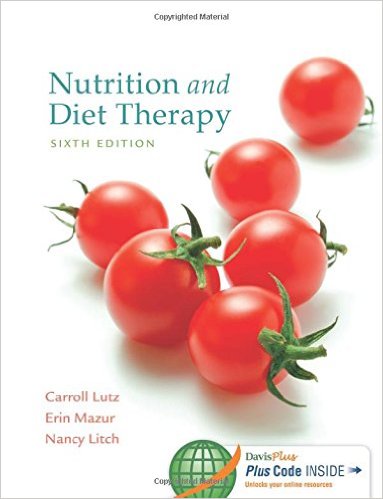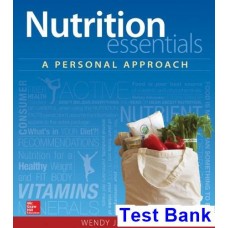Test Bank For Nutrition And Diet Therapy- 6th Edition by Carroll A. Lutz and Erin E. Mazur
Original price was: $55.00.$20.00Current price is: $20.00.
Test Bank For Nutrition And Diet Therapy- 6th Edition By Carroll A. Lutz And Erin E. Mazur is a great resource for anyone looking to learn more about nutrition and diet therapy. This book provides readers with the latest information on topics such as energy balance, weight management, and food insecurity.
In addition, Test Bank For Nutrition And Diet Therapy- 6th Edition By Carroll A. Lutz And Erin E. Mazur also includes updated coverage of new research on the role of nutrients in chronic disease prevention and management. As a result, this book is an essential read for anyone interested in optimizing their health through diet and nutrition.
Digital item No Waiting Time Instant Download
Description
Test Bank For Nutrition And Diet Therapy- 6th Edition by Carroll A. Lutz and Erin E. Mazur
Chapter 3: Fats
1. The descriptive name for fats of all kinds is:
1. Complete
2. Essential
3. Lipids
4. Saturated
Ans: 3
Feedback
1.
Complete is not a term used when referring to all types of fat.
2.
Essential is not a term used when referring to all types of fat. Essential nutrients are those that are required by the body that must be consumed because the body cannot manufacture them.
3.
The descriptive name for all fats is lipids and includes true fats and oils as well as related fat compounds such as lipoids and sterols.
4.
Saturated is a term that refers to one type of fat, that is the type that is filled with as many hydrogen atoms as the carbon atoms can bond with and has no double bonds between the carbons.
KEY: Integrated Process: Nursing Process | Client Need: Physiological Integrity: Basic Care and Comfort | Cognitive Level: Knowledge
2. Fat contains ______ kcal/g.
1. 2.2
2. 4
3. 7
4. 9
Ans: 4
Feedback
1.
One gram of fat yields 9 kilocalories.
2.
One gram of fat yields 9 kilocalories
3.
One gram of fat yields 9 kilocalories
4.
Each gram of fat contains 9 kilocalories.
KEY: Integrated Process: Nursing Process | Client Need: Physiological Integrity: Basic Care and Comfort | Cognitive Level: Knowledge
3. Which of the following is not a function of fat in the body?
1. Build scar tissue
2. Lubricate body tissues
3. Pad vital organs
4. Provide energy
Ans: 1
Feedback
1.
Fats are not involved in building scar tissue.
2.
Fats lubricate body tissues.
3.
Fatty tissue cushions and protects vital organs.
4.
Fats supply fuel to most tissues and serves as the body’s main fuel or energy reserve.
KEY: Integrated Process: Nursing Process | Client Need: Physiological Integrity: Basic Care and Comfort | Cognitive Level: Comprehension
4. Which of the following would a nurse suggest as a lean meat?
1. Ground beef, pork chops, and mozzarella cheese
2. Corned beef, spare ribs, and Swiss cheese
3. Round steak, pork tenderloin, and cottage cheese
4. Dark-meat chicken, eggs, and bologna
Ans: 3
Feedback
1.
Lean meat contains 1 to 3 grams of fat. Ground beef, pork chops, and mozzarella cheese contain 5 grams of fat.
2.
Lean meat contains 1 to 3 grams of fat. Corned beef contains 5 grams of fat. Spare ribs and Swiss cheese contain 8 grams of fat.
3.
Round steak, pork tenderloin, and cottage cheese are considered lean meats because each contains 3 grams of fat.
4.
Lean meat contains 1 to 3 grams of fat. Dark meat chicken and eggs contain 5 grams of fat. Bologna contains 8 grams of fat.
KEY: Integrated Process: Teaching/Learning | Client Need: Physiological Integrity: Basic Care and Comfort | Cognitive Level: Application
5. What percentage range of an adult’s kilocalories is recommended as the maximum to be obtained from fat?
1. 20 to 30
2. 20 to 35
3. 30
4. More than 50
Ans: 2
Feedback
1.
The recommendation is for adults to have 20% to 35% of kilocalories from fat.
2.
The recommendation is for adults to have 20% to 35% of kilocalories from fat.
3.
The recommendation is for adults to have 20% to 35% of kilocalories from fat.
4.
The recommendation is for adults to have 20% to 35% of kilocalories from fat.
KEY: Integrated Process: Nursing Process | Client Need: Health Promotion and Maintenance | Cognitive Level: Comprehension
6. Fats are classified as saturated, monounsaturated, or polyunsaturated based on which of the following?
1. Appearance after cooking
2. Source, whether animal or vegetable
3. Type of chemical bonds in their fatty acids
4. Ease of emulsification
Ans: 3
Feedback
1.
The degree of saturation used for classification is based on the extent to which hydrogen is joined to the carbon atoms present. It has nothing to do with appearance.
2.
The source of the fat does not determine the saturation.
3.
The type of chemical bond in the fatty acids determines the saturation of the fat.
4.
The ease of emulsification does not determine the saturation of the fat.
KEY: Integrated Process: Nursing Process | Client Need: Physiological Integrity: Basic Care and Comfort | Cognitive Level: Comprehension
7. Which of the following would a nurse instruct a patient to use for one fat exchange?
1. 1 tablespoon of butter
2. 1/2 ounce of cream cheese
3. Two slices of bacon
4. 3 tablespoons of mayonnaise
Ans: 2
Feedback
1.
Each fat exchange provides 5 grams of fat. A teaspoon of butter would contain 5 grams of total fat. So a tablespoon would contain 15 grams of fat.
2.
Each fat exchange provides 5 grams of fat. A 1/2 ounce amount of cream cheese would provide 5 grams of fat.
3.
Each fat exchange provides 5 grams of fat. One slice of bacon, not two, would provide 5 grams of fat.
4.
Each fat exchange provides 5 grams of fat. One teaspoon of mayonnaise, not 3 tablespoons, would provide 5 grams of fat.
KEY: Integrated Process: Teaching/Learning | Client Need: Physiological Integrity: Basic Care and Comfort | Cognitive Level: Application
8. To be labeled “lean,” a product must have no more than ______ g of fat per 3 1/2-ounce serving.
1. 5
2. 10
3. 15
4. 20
Ans: 2
Feedback
1.
Lean can be used on meat, poultry, seafood, or game meat products only if the product contains less than 10 grams of fat, less than 4.5 grams of saturated fat, and less than 95 milligrams of cholesterol per 100-gram serving (3.5 ounces).
2.
Lean can be used on meat, poultry, seafood, or game meat products only if the product contains less than 10 grams of fat, less than 4.5 grams of saturated fat, and less than 95 milligrams of cholesterol per 100-gram serving (3.5 ounces).
3.
Lean can be used on meat, poultry, seafood, or game meat products only if the product contains less than 10 grams of fat, less than 4.5 grams of saturated fat, and less than 95 milligrams of cholesterol per 100-gram serving (3.5 ounces).
4.
Lean can be used on meat, poultry, seafood, or game meat products only if the product contains less than 10 grams of fat, less than 4.5 grams of saturated fat, and less than 95 milligrams of cholesterol per 100-gram serving (3.5 ounces).





Be the first to review “Test Bank For Nutrition And Diet Therapy- 6th Edition by Carroll A. Lutz and Erin E. Mazur”